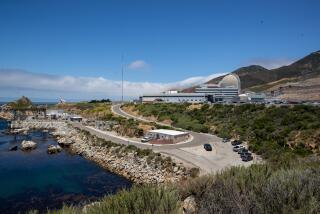Senator seeks to block California reactor license renewals pending seismic study
State Sen. Sam Blakeslee said Monday that he would try to block Pacific Gas & Electric’s licenses to run one of the state’s two coastal nuclear power plants unless the utility withdraws its renewal application pending a seismic study of the facility’s site.
Blakeslee, a San Luis Obispo Republican whose district includes the Diablo Canyon nuclear plant, wants to know the potential effect of a recently discovered fault line near there.
“I’m concerned mostly about this culture of disregard of risk,” said Blakeslee, who has a doctorate in geophysics. “It’s potentially putting my constituents in a place of great risk.”
The lawmaker made his demand at a legislative hearing on whether Diablo Canyon and the San Onofre plant in San Diego County could safely handle the level of earthquakes and tsunamis possible in those locations.
Steve David, director of site services for the PG&E plant, said he lacked the authority to promise Blakeslee that his company would withdraw its license renewal bid until the seismic study was done but would take the request to his bosses.
Blakeslee and other legislators spent the afternoon grilling utility executives on the potential effects of a disaster like the one that has left Japanese officials desperate to avert a catastrophic meltdown.
The two plants’ operators said they could handle the maximum earthquake and tsunami predicted for their locales. Skeptical lawmakers pointed out repeatedly that the 9.0 earthquake off the coast of Japan far exceeded expectations there.
“In light of the disaster in Japan, I think the average person’s response is: We should be safer,” said Sen. Christine Kehoe (D-San Diego). “They weren’t expecting a 9.0 earthquake.”
PG&E has applied to the federal Nuclear Regulatory Commission for licenses that would allow the Diablo Canyon plant to operate until 2045. Current licenses for its two reactors are good through 2024 and 2025.
Blakeslee wants the company to complete detailed, three-dimensional modeling of the potential hazards posed by the newly detected fault. He became visibly agitated after asking Lloyd Cluff, PG&E’s director of earthquake risk management, if he was concerned about the unknown dangers posed by the new fault.
“There’s uncertainty in everything,” Cluff said, adding that the company’s scientists had built the new fault into their risk models. “We don’t see a concern about the uncertainty.”
Sen. Elaine Alquist (D-Santa Clara), some of whose constituents were killed in PG&E’s natural gas pipeline explosion in San Bruno last September, told the executives how “frustrated” she has been trying to get public safety information out of the company.
“I just don’t find PG&E truly forthcoming in addressing these issues,” Alquist said.
PG&E also came under criticism because inspectors in 2009 discovered that valves meant to allow water in to cool the reactors in an emergency had been stuck shut for a year and a half.
David told members of the Senate Select Committee on Earthquake and Disaster Preparedness, Response and Recovery that there were backup systems to operate the valves if needed.
David also noted that the plant sits on a ledge of bedrock 85 feet above sea level, where it would presumably be safe from all but the most catastrophic tsunami waves. Five million gallons of water needed to cool the reactors and spent fuel ponds in an emergency is stored in two reservoirs farther up the hill, at 310 feet, he said.
As PG&E executives took most of the heat, Caroline McAndrews, director of licensing for Southern California Edison’s San Onofre plant, awaited her turn. When it came, Kehoe noted that the plant was built to withstand a magnitude 7 earthquake, but last year’s Easter temblor across the border in
Baja California reached 7.2.
“We do evaluate for the probability of those larger earthquakes,” McAndrews said, “and we have confidence.”
More to Read
Start your day right
Sign up for Essential California for news, features and recommendations from the L.A. Times and beyond in your inbox six days a week.
You may occasionally receive promotional content from the Los Angeles Times.







